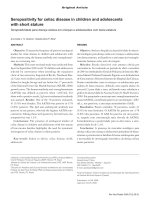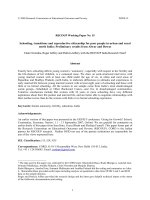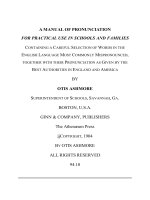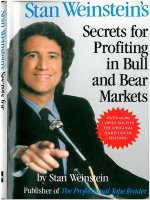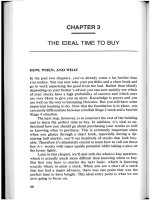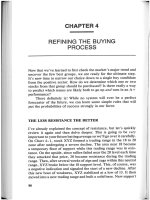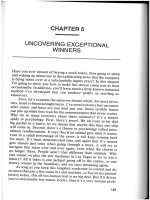Monthly cash machine powerful strategies for selling options in bull and bear markets
Bạn đang xem bản rút gọn của tài liệu. Xem và tải ngay bản đầy đủ của tài liệu tại đây (617.24 KB, 43 trang )
Monthly Cash Machine
Powerful Strategies for Selling Options in Bull and
Bear Markets
Matthew R. Kratter
www.trader.university
Copyright © 2016 by Little Cash Machines LLC
All rights reserved. No part of this book may be reproduced in any form
without written permission from the author ().
Reviewers may quote brief passages in reviews.
Disclaimer
Neither Little Cash Machines LLC, nor any of its directors, officers,
shareholders, personnel, representatives, agents, or independent contractors
(collectively, the “Operator Parties”) are licensed financial advisers,
registered investment advisers, or registered broker-dealers. None of the
Operator Parties are providing investment, financial, legal, or tax advice, and
nothing in this book or at www.Trader.University (henceforth, “the Site”)
should be construed as such by you. This book and the Site should be used as
educational tools only and are not replacements for professional investment
advice. The full disclaimer can be found at the end of this book.
Table of Contents
Chapter 1: The Power of Monthly Cash Flow
Chapter 2: How to Trap a Stock in a Box
Chapter 3: How to Take Wing with Iron Condors
Chapter 4: Selling Spreads for Profits
Chapter 5: Financial Freedom and Monthly Cash Flow
Keep Learning With These Trading Books
Your Free Gift
About the Author
Disclaimer
Your Free Gift
Thanks for purchasing my book!
As a way of showing my appreciation, I’ve created a FREE BONUS
CHAPTER for you.
In this bonus chapter, I provide another advanced trading system that will
allow you to use put and call options to generate monthly cash flow.
After my book’s initial publication, many of my readers asked for additional
ways to use options to create cash flow.
In this free bonus chapter, I will give you a step-by-step guide to trading
options for monthly cash flow, including when to enter, when to exit, and
when to take profits.
>>>Tap Here to Grab Your Free Bonus Chapter<<<
Chapter 1: The Power of Monthly Cash Flow
back to top
Once upon a time, there was a man who traded stocks.
One day he bought a stock, and it went up.
That made him happy.
So he sold the stock.
But then the stock kept going up.
Now he was sad.
So he bought another stock.
But that stock went down.
Now he was sad.
“Why did I ever buy that stock?” he wondered.
So he bought another stock.
But that stock just sat there and did nothing.
Now he was tired.
“I am tired of having to know when a stock will go up, and when a
stock will go down,” he said.
When you buy a stock, there are 5 different things that can happen:
1. The stock can go up a lot.
2. The stock can go up a little.
3. The stock can do nothing (“trade sideways”).
4. The stock can go down a little.
5. The stock can go down a lot.
The best scenario occurs when you are correctly positioned for a large move:
• You buy a stock, and it immediately goes up a lot (#1 above).
• You short a stock, and it immediately goes down a lot (#5 above).
In both cases, you can lock in your profits, having captured the bulk of the
move.
But even if you are a professional trader, capturing these large quick moves
can be quite difficult.
The worst scenario occurs more frequently, especially for amateur traders
(and the chronically unlucky):
You buy a stock, and it immediately goes down a lot (#5 above).
Or, you short a stock, and it immediately goes up a lot (#1 above).
The middle scenario is the most common. You buy a stock and it moves up a
little, down a little, or just trades sideways (#2, #3, and #4 above).
Being in such a stock can be like watching paint dry.
And not only is it boring, but it is also expensive.
Time is money. If you are stuck in a stock that is not moving, there is a real
opportunity cost. You could have instead had your money in a stock that was
moving, or in a CD that was earning interest.
We can see that it is often difficult to know whether a given stock will go up
or down. And it costs us money if we are in a stock that moves the wrong
way—or doesn’t move at all.
So what is a trader to do?
I had been trading for many years before I realized that it was possible to
make a lot of money from a stock that was doing pretty much nothing.
But how is this possible?
Isn’t a dead stock the complete opposite of a red-hot stock?
And whoever signed up for a stock newsletter about stocks that are about to
do nothing?
Yet, as it turns out, there is a market that is willing to pay you big dollars for
just these kinds of stocks.
That market is the options market.
You see, there are two types of people in the options market: the insured, and
the insurers.
The insured are those who need to buy insurance. Maybe you own a large
block of stock, and want to make sure that for the next year, you will always
be able to sell that stock at 100 or higher.
So you use the options market to take out an insurance policy to protect
yourself.
Most people think like the insured. We are all used to writing big checks to
insurance companies for our cars and homes.
What we are not used to is being on the receiving side of those checks.
When you are an insurance company (insurer), you get used to people giving
you money.
Every once in a while, you might need to pay out a claim.
But most of the time, you just smile to yourself on the way to the bank and
cash the checks.
This book will teach you how to set up your own personal “insurance
company” in the options market.
You will learn how to think like an insurer.
You will learn how to evaluate a given situation and weigh the risks against
the rewards.
And in the process, you will learn how to turn boring stocks into big monthly
(or even weekly) paychecks.
This book will teach you everything you need to know in order to
successfully sell options for money, even if you have never traded options
before.
The next couple of chapters may make your head hurt a little at times, but
stick with me. Once you get the hang of it, you will be able to quickly
evaluate the risk/reward of an options position.
Selling options will become second nature to you.
In the meantime, get out a pen and paper, and take some notes. If you get
stuck, I’m always here to answer your questions: email me at
I always enjoy hearing from my readers.
It’s time to make some money the smart and easy way—so let’s get started!
Chapter 2: How to Trap a Stock in a Box
back to top
Many options trading books begin with advanced theory, and a lot of jargon
about credit spreads, gamma, vega, etc.
We’ll take an easier route and begin with a practical example.
In the process, we will reinvent something called “iron condors” from the
ground up. There’s no better way to understand a trading strategy than to
build it yourself, brick by brick.
So let’s get started.
Suppose that you come across a stock (“XYZ”) that has the following
characteristic: it has been stuck in a range between 110 and 120 for the last
six months.
And let us further suppose that there is a real-world reason (as there often is)
for this range-bound behavior:
The management team (CEO, COO, etc.) are heavy sellers of XYZ around
120. And they own a lot of stock, so we can reasonably assume that they will
continue to unload their positions over the next few months.
And there is a large institutional investor (a value investing hedge fund) that
is accumulating XYZ around 110.
Because of these large players at either end, XYZ has been forced to trade in
a range between 110 and 120.
There are a few different ways to profit from a situation like this, especially if
we believe that the sellers will keep selling around 120 (perhaps they still
own many shares, and have been consistent monthly sellers). And if we
believe that the hedge fund buyer will keep buying around 110 (perhaps in
the reported filings, it is still a small position relative to the assets under
management, so we can assume that they will continue to scale it up).
One could simply wait until XYZ traded close to 111 or so, and then buy
some shares, knowing that there was reasonably strong support for the stock
provided by the hedge fund at 110.
As XYZ got close to 120, one could sell off these shares for a profit
(preferably in the 118-119 range, so as not to compete with the insider selling
around 120).
If one wanted to get fancy, one could then sell short some shares around 119,
and cover the short when the stock fell back down to 111 or so.
And, theoretically, one could play this range again and again, making
multiple round-trips. In theory, one could make quite a bit of money.
Unfortunately, the real-world does not always respect the theory.
For example, what if XYZ decided to just hang out around 115 and do
nothing? Then we would be stuck. We could sell the shares that we bought at
111 for a profit, but we would be unable to reload our position until the stock
got back down to 111.
In the meantime, we’re back to watching paint dry.
So we decide to structure our own special little trade, with the stock just
sitting there at 115 (let’s pretend that today is January 21).
We’re reasonably certain that the stock will not trade above 120 for any
significant length of time, because of the aggressive insider sellers at 120. If
the stock trades above 120, they will probably accelerate their stock sales
until the stock is driven back below 120.
Because of this, we are comfortable selling (“sell to open” is the order type
that you should use with your broker) 10 XYZ Mar 120 calls at 1.40.
Let’s first review some basic options terminology.
A “call option” (or just a “call”) is a contract that gives you the right to buy a
stock at a certain price, over a certain period of time, until the option expires.
If you own a call option (“are long a call”), you have the right to buy the
stock, but you don't have to buy the stock.
So, for example, let’s look at the XYZ Mar 120 calls that we are interested in
selling.
“XYZ” is simply the ticker of the underlying stock, in this case a made-up
company that we will call “The XYZ Corporation.”
“Mar” is short for “March,” which is the option’s “expiration date.” This is
the month when the options contract expires. Expiration usually occurs at the
end of the day on the 3rd Friday of the month (let’s say it’s March 18 this
year). At expiration, the contract goes away forever.
“120” is the “strike price”: this is the price at which the owner of the call
option has the right to purchase the stock (or “call it away” from its owner,
hence the name “call”).
If you buy a call (“if you are long a call”), you are betting that the stock will
move up in price.
If you sell a call (“if you are short a call”), you are betting that the stock will
stay roughly where it is, or move down in price.
That is why on January 21 (today) we decided to sell ten March call options
on XYZ, with a strike price of 120, when the underlying stock is just sitting
there at 115.
Now notice that with options, you can sell something that you don’t already
own.
We don’t own the March options, but we can sell them anyway, which makes
us “short” the March options.
Because we sold something, we were paid some money. In this case, we were
paid $1.40 per contract. Each call option controls 100 shares of stock, so we
were paid $1.40 times 10 call options times 100 shares of stock per option
(1.40 x 10 x 100) equals $1,400 (not counting the commission, which should
be less than $10, if you are using the right options broker).
What happens to these March 120 calls at expiration (on March 18)?
Well, that depends on where the underlying stock XYZ is trading at
expiration. If the stock is trading at 120 or below, the options expire
worthless, and we get to keep the $1,400 (again, not counting commissions).
If the stock is trading at 122 at expiration, the 120 call options will be worth
122 minus 120, or 2.00 at expiration. 2.00 times 10 call options times 100
shares per option equals $2,000. If you are long the call options, they are
worth $2,000 at expiration, and you are very happy.
But we sold the call options (we are “short” the call options), so they are
worth negative $2,000 to us. We collected $1,400 when we first sold the call
options, but now they are worth negative $2,000, so we have essentially lost
$600 ($1,400 minus $2,000).
What if XYZ gets a buyout offer from another company, and XYZ’s stock
shoots up to 150 by expiration? Well, then the options are each worth 30 (150
minus the strike price of 120 equals 30). 30 times 10 call options times 100
shares per option equals negative $30,000, since we are short the call options.
We collected $1,400 when we entered the trade, but now they are worth
negative $30,000, so we have lost $28,600.
This is obviously a complete disaster!
Always keep in mind that if you sell a call option, and the underlying stock
moves up a lot in price, you can lose a lot of money, and end up having to
buy back the call at a higher price to exit the trade (you can “buy to close”
any short option position at any time before expiration, if you so choose). If
you are short only a call, it is called a “naked call.” It is a naked call because
you are “exposed” to sharp up-moves in the stock.
We know that there is heavy insider selling in XYZ at 120, so it seems
unlikely that the stock would receive a buyout offer at 150 in just 2 months.
If this were in the cards, the insiders would probably have known about it,
and thus not been aggressive sellers of their stock at 120.
But, as you know, anything can happen in the markets. We need to protect
ourselves against a nasty move like this when we are short the 120 calls.
So, let’s cap our maximum loss by buying 10 XYZ Mar 122 calls at 0.95 (the
latter price is set by the market).
To review, these are call options, whose strike price is 122 and that expire on
same day as our 120 calls, namely the third Friday of March. We pay 0.95
per options contract, so it costs us 10 contracts times 0.95 per contract times
100 shares per contract, or $950.
There is no out-of-pocket cost to us (except a commission of about $10),
since we have just received $1,400 by selling the 120 calls.
We received $1,400 and paid $950, which gives us a net credit to our account
of $450, or about $430 after commissions.
Now let’s see how this has changed our risk profile.
If XYZ shoots to 150, our short 120 call position is still worth negative
$30,000. Fortunately, however, our long 122 call position is then worth 28
per contract (150 stock price minus the strike price of 122 equals 28). 28 per
contract times 10 contracts times 100 shares per contract equals $28,000.
Notice that since we are long the 122 call options (we bought the calls, not
sold them), this $28,000 is a positive number for us.
So we have made $28,000 on our long 122 calls position, and lost $30,000 on
our short 120 calls, for a net loss of $2,000. This is certainly much more
manageable than our previous loss of $30,000 when we were short the naked
120 calls.
If you do the math, you will see that this combined position can never lose
more than $2,000, whether the stock is at 122 or 150 or 1500. The maximum
loss starts when the stock is at 122, because at that point the short 120 calls
are worth negative $2000, and the long 122 calls are worth zero (122-122
equals zero).
The maximum profit of this combined position occurs when the stock is at
120 or below at expiration. At that point, the 122 calls will be worthless (we
paid $950 for them), but the 120 calls will also be worthless (we collected
$1,400 when we sold them, and they expired worthless). So again we paid
$950 and were paid $1,400, for a net profit of $450, or $430 after
commissions.
When we sold the 120 calls and bought the 122 calls, we were putting on a
position that is called a “vertical spread”—“vertical” because the 2 strike
prices are on top of each other.
It is also called a “call spread,” since it is built using call options. It is also
known as a “bear call spread” (since it makes money if the underlying stock
does not rally) or “credit call spread,” since our account received net cash (or
a credit) when the position was put on.
There is no need to learn all of this fancy terminology upfront, though it may
come in handy if you ever need to talk to your broker over the phone.
All you need to know at this point is that we simply constructed a trade that
would make money if XYZ stayed below 120, and would not lose a ton of
money if XYZ went above 120.
Now it is time to do something similar to the 110 strike of XYZ.
For this leg of the trade, we are going to sell (“sell to open” is the order type
that you should use with your broker) 10 XYZ Mar 110 puts at 1.24 (again,
this latter price is set by the options market).
Just as we did with our call options, we must now learn a little terminology
about put options.
A “put option” (or just a “put”) is a contract that gives you the right to sell a
stock at a certain price, over a certain period of time, until the option expires.
If you own a put option (“are long a put”), you have the right to sell the
stock, but you don’t have to.
So, for example, let’s look at a XYZ Mar 110 puts.
Again, “XYZ” is simply the ticker of the underlying stock, in this case a
made-up company that we called “The XYZ Corporation.”
“Mar” is short for “March,” which is the put option’s “expiration date.”
“110” is the “strike price”: this is the price at which the owner of the put
option has the right to sell the stock (or “put it away” on to someone else,
hence the name “put”).
If you buy a put (“if you are long a put”), you are betting that the stock will
move down in price.
If you sell a put (“if you are short a put”), you are betting that the stock will
not move down in price.
We sold the 110 puts, because we believed that the stock XYZ should not
trade below 110 for any significant length of time (over the next 2 months),
because of the large institutional buyer who has been accumulating at 110.
Because we sold something, we were paid some money. In this case, we were
paid $1.24 per contract. Each put option controls 100 shares of stock, so we
were paid $1.24 times 10 call options times 100 shares per option (1.24 x 10
x 100) equals $1,240 (again, not counting commissions, which should not be
more than $10 for this trade).
What happens to these March 110 puts at expiration?
Well, that depends on where the underlying stock XYZ is trading at
expiration. If the stock is trading at 110 or above, the put options expire
worthless, and we get to keep the $1,240.
If the stock is trading at 108 at expiration, the 110 put options will be worth
110 minus 108, or 2.00 at expiration. 2.00 times 10 put options times 100
shares per option equals $2,000.
If you are long the put options and XYZ is at 108 at expiration, the put
options are worth $2,000, and you are very happy.
But we sold the put options (we are “short” the put options), so they are
worth negative $2,000 to us. We collected $1,240 when we first sold the put
options, but now they are worth negative $2,000, so we have essentially lost
$760 ($1,240 minus $2,000), not counting our $10 in trading commissions.
Now what if XYZ reports corporate accounting irregularities (“Our former
CFO was cooking the books”), and XYZ’s stock immediately plummets to 80
and remains there until expiration?
Well, then the put options are each worth 30 (110 strike price minus the stock
price of 80 equals 30). 30 times 10 put options times 100 shares per option
equals negative $30,000, since we are short the put options. We collected
$1,240 when we entered the trade, but now they are worth negative $30,000,
so we have lost $28,760.
Another complete disaster!
Again, always keep in mind that if you sell a put option, and the underlying
stock moves down a lot in price, you can lose a lot of money, and end up
having to buy back the put at a higher price to exit the trade (you can “buy to
close” any short option position at any time before expiration, if you so
choose).
If you are short a put option, it is called a “naked put”—again “naked”
because you are “exposed” to sharp down-moves in the stock.
We know that there is heavy (probably “smart money”) institutional buying
in XYZ at 110, so it seems unlikely that the stock could report accounting
problems and plummet to just 80 in 2 months. If this were obvious, the hedge
fund would not have been scooping up stock at 110.
Again, as you know, anything can happen in the markets. We need to protect
ourselves against a nasty move like this when we are short the 110 puts.
So, let’s cap our maximum loss by buying 10 XYZ Mar 108 puts at 0.77 (the
latter price is, as always, set by the options market).
To review, these are put options, whose strike price is 108 and that expire on
same day as our 110 puts, namely the third Friday of March. We pay 0.77 per
options contract, so it costs us 10 contracts times 0.77 per contract times 100
shares per contract, or $770.
There is no out-of-pocket cost to us (apart from another $10 commission),
since we have just received $1,240 by selling the 110 puts.
We received $1,240 and paid $770, which gives us a net credit to our account
of $470, or $450 after commissions.
Now let’s see how this has changed our risk profile.
If XYZ plummets to 80, our short 110 put position is still worth negative
$30,000. Fortunately, our long 108 put position is now worth 28 per contract
(108 strike price minus the stock price of 80 equals 28). 28 per contract times
10 contracts times 100 shares per contract equals $28,000. Notice that since
we are long the 108 put options (we bought the puts, not sold them), this
$28,000 is a positive number for us.
So we have made $28,000 on our long 108 puts position, and lost $30,000 on
our short 110 puts, for a net loss of $2,000 (plus an additional $20 from
trading commissions). This is certainly much more manageable than our
previous loss of $30,000 when we were short the naked 110 puts.
If you do the math, you will see that this position can never lose more than
$2,000, whether the stock is at 108 or 80 or zero. The maximum loss starts
when the stock is at 108, because at that point the short 110 puts are worth
negative $2000, and the long 108 puts are worth zero (108-108 equals zero).
The maximum profit of this combined put position occurs when the stock is
at 110 or above at expiration. At that point, the 108 puts will be worthless
(we paid $770 for them), but the 110 puts will also be worthless (we collected
$1,240 when we sold them, and they expired worthless). So again we paid
$770 and were paid $1,240, for a net profit of $470, or $450 after
commissions.
When we sold the 110 puts and bought the 108 puts, we were putting on
another “vertical spread”—“vertical” because the 2 strike prices are on top of
each other.
It is also called a “put spread,” since it is built using put options. It is also
known as a “bull put spread” (since it makes money if the underlying stock
does not fall) or “credit put spread,” since our account received net cash (or a
credit) when the position was put on.
Again, there is no need to learn all of this fancy terminology upfront.
All you need to know at this point is that we simply constructed a trade that
would make money if XYZ stayed above 110, and would not lose a ton of
money if XYZ went below 110.
Now let’s take a big step back and look at the overall structure that we have
created:
1. We sold a 120/122 call spread on XYZ, that will make us $430 after
commissions, if XYZ is at or below 120 at expiration.
2. Then we sold a 108/110 put spread on XYZ, that will make us $450
after commissions, if XYZ is at or above 110 at expiration.
Taken together, these two positions are—guess what?
An Iron Condor!
In options parlance, we bought 10 XYZ Mar 108/110/120/122 iron condors.
In everyday speech, we placed a trade that will make us $880 ($430 plus
$450) if XYZ closes between 110 and 120 at expiration.
Our maximum loss will be $1,120 ($880 premium collected minus $2,000
lost), if XYZ is at or below 108, or at or above 122 at expiration.
So we are risking $1,120 to make $880. That’s a 78% return on capital at risk
—in just 2 months!
If you can do this successfully 6 times a year (i.e. every 2 months), you will
bring in an extra $5,280 in income every year.
At the beginning of this book, we discussed how difficult it is to know where
a stock is going to go.
Here, all we needed to know was where a stock was not going to go.
If we think that a stock is about to move up sharply, of course we should buy
the stock.
If we think that a stock is about to move down sharply, of course we should
short the stock (or at the very least, not own the stock!).
But if we don’t have a strong opinion about a sharp move coming, we are
usually best off doing an iron condor instead, and collecting the $5,280.
Let someone else pay for the insurance.
We’ll just sit here and collect the checks, like an insurance company does.
In the next chapter, we’ll talk more about how and when to trade iron
condors.
Chapter 3: How to Take Wing with Iron Condors
back to top
The best way to begin with iron condors is to look for a stock with a daily
chart that shows the stock to be trapped within a trading range like this:
One can then sell a call spread at the top of the range, and also sell a put
spread at the bottom of the range, to create an iron condor. Ideally, you want
to put this iron condor on when the stock is near the middle of the trading
range.
So if the top of the range is 50, one could sell 10 calls with a 50 strike price,
and buy 10 calls with a 51 strike price.
If the bottom of the range is 40, one could sell 10 puts with a 40 strike price,
and buy 10 puts with a 39 strike price.
I usually like to sell my spreads with an expiration date that is about 30-45
days out. These final days are when the sharpest time decay of the options
takes place, which hurts an options buyer, but helps an options seller like us.
One can also play around with the weightings on either end of the iron
condor.
So for example, in the above chart, suppose that you are extra certain that the
stock will not trade below 40 for any length of time. But that you are less
certain that the stock will not trade above 50 (because, for example, we are
entering a strong bull market). In this scenario, you could sell 10 puts
spreads, but only 5 call spreads.
Or, if you were extra bearish on the stock, you could do the reverse and sell
10 call spreads, and sell only 5 put spreads.
The possibilities are endless, and can be tailored to your particular financial
situation, as well as general market conditions.
Do you think that the S&P 500 is going to be trapped between 1820 and 2130
over the coming year (this has been the trading range since late 2014)? You
could sell a 182/183 SPY put spread, and sell a 213/214 call spread, to create
an iron condor on the current trading range of the S&P 500.
If you think that there is a bigger chance that we are in a bear market, you
could sell twice the number of call spread contracts. Or vice versa, if you
think that we are still in a bull market. Again, the possibilities are endless.
Sometimes I am asked which strikes to use for an iron condor. This is entirely
the preference of the trader, and is more of an art than a science. However,
when you are first getting started with iron condors, my general guideline
would be to not make the “wings” too wide. So, for example, sell the 39/40
put spread, rather than the 38/40 put spread. And sell the 50/51 call spread,
rather than the 50/52 call spread.
Once you have decided which strike prices to use, login to your broker and
get a quote for the call spread that you are thinking of selling. Be sure to note
the projected credit that you will receive. Find the midpoint of the bid and the
offer, and assume that this is the price that you will get executed at, or
slightly worse.
Now do the same thing for the put spread that you are thinking of selling.
Then get a quote for the entire iron condor. The sum of the call spread credit
and the put spread credit should be pretty close to the credit for the iron
condor as a whole.
When looking at the iron condor quote, take the midpoint of the bid/ask
spread, and ask yourself if you would be happy getting that price. If the
premium collected is too low (especially relative to the projected maximum
possible loss on the trade), then look for a different iron condor to trade.
Again, this is more of an art than a science. The more you trade iron condors,
the more you will learn what risk/reward ratio works for you.
Be careful—depending on the broker that you are using, the same transaction
could be labelled “sell an iron condor” or “buy an iron condor.” For most
brokers, you will want to “buy an iron condor” to enter the trade, and “sell an
iron condor” to exit the trade, if you are pursuing the strategy laid out in this
book.
The best way to be sure of which transaction you are doing is to set up a
paper-trading account (where no money is involved) with your broker, or
simply to place a very small trade (1 contract for each leg of the iron condor).
Before you place the trade, be sure that the broker tells you that you are about
to receive a “credit” on the trade. If it says that you are about to receive a
“debit,” then you have entered the order backwards and should instead do the
opposite, whether that is buying or selling the iron condor.
When you are first getting started, you should enter all legs of the iron condor
simultaneously, by placing a single order. Find the midpoint of the bid/ask
spread of the iron condor and then place a limit order, specifying a price that
is 5 cents above the midpoint (if you are buying an iron condor), or 5 cents
below the midpoint (if you are selling an iron condor).
For example, if the iron condor market is bid at 1.00 and offered at 1.40, the
midpoint is 1.20. If you are buying an iron condor, start off by placing your
limit order at 5 cents better than 1.20, or 1.25. If you are lucky, you will get
filled.
If you have not been filled on your trade after 5 minutes, you may have to
reenter your limit price 5 cents lower (1.20, in this case). Remember that you
do not have to enter this trade if you do not like the price. Always have a
limit on how low you are willing to go. If you cannot get filled at a price that
you like, cancel your order and look for another iron condor that offers a
better risk/reward ratio.
When you become more advanced, you can leg into the position by first
putting on the call spread, and then the put spread (or vice versa).
Some advanced traders even choose to put on all 4 legs separately. The
timing of this can be tricky, though. You’ll want to put on the short call on an
intraday rally, then leg into the long call leg on an intraday pullback. For the
short put, you’ll want to enter on an intraday pullback, and then buy the long
put on an intraday rally.
It can be dangerous putting on these legs separately, as you are quite exposed
if the stock makes a sudden large intraday move in one direction. Imagine
being short a naked call on a stock that gets a buy-out offer intraday! For this
reason, it will often make sense to leg into the long call before the short call,
and the long put before the short put.
When you buy an iron condor, you will immediately receive the credit into
your brokerage account. You cannot withdraw this credit until the trade is
closed.
At the same time, the broker will also take your maximum possible loss from
the trade (from either the call spread side of the trade or the put spread side of
the trade, whichever is greater) and set it aside as a “maintenance
requirement.” You will not have the use of this cash to place other trades as
long as your iron condor trade is still on.
When I am trading a stock’s range, I will enter the iron condor, and then try
not to look at my position until about 2 weeks before expiration. I already
know my maximum profit and loss, and I do not want the market to distract
me with its volatility.
I always exit (or roll) my iron condor at least 2 weeks before expiration.
If you hold any closer to expiration, you risk having your short put or short
call assigned. If a short put is assigned, you will end up with a long position
in the stock at the strike price. If a short call is assigned, you will end up with
a short position in the stock at the strike price.
In either case, it’s not the end of the world, as you can exit your stock
